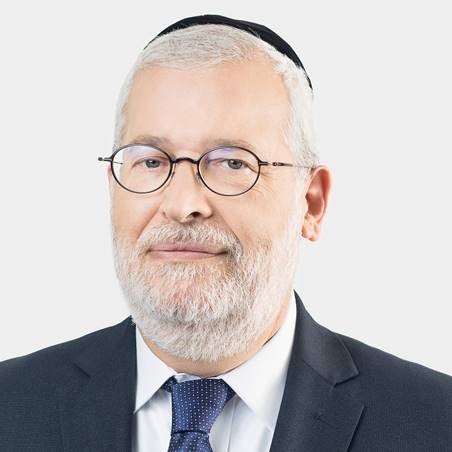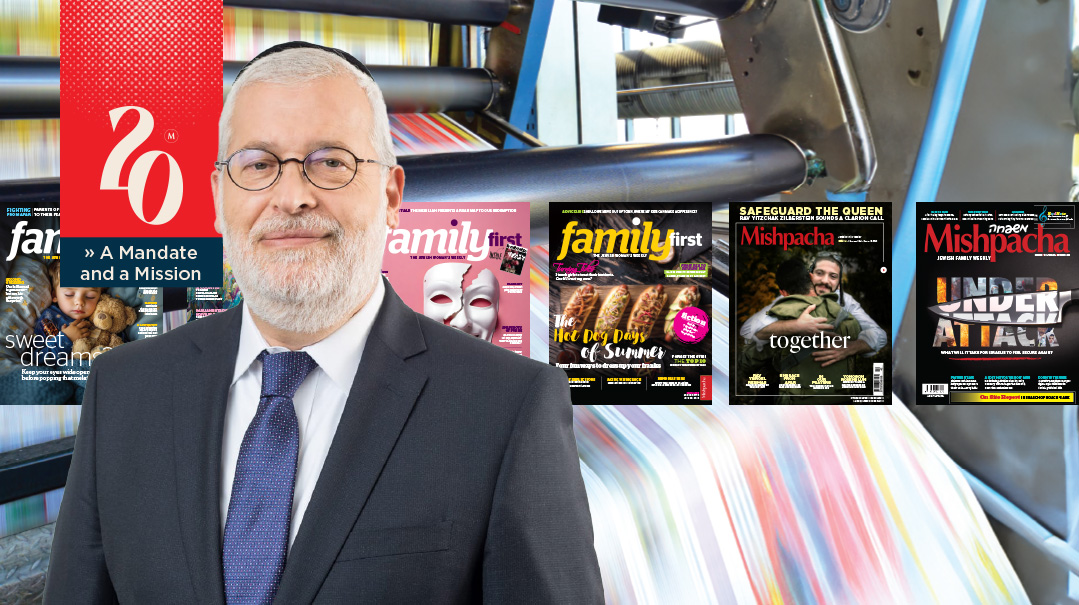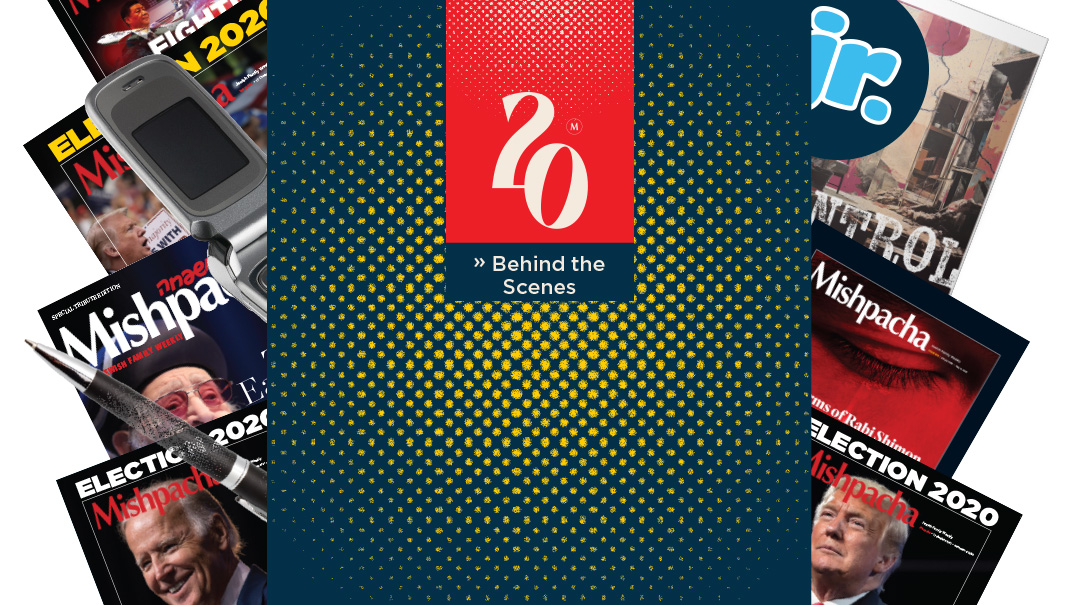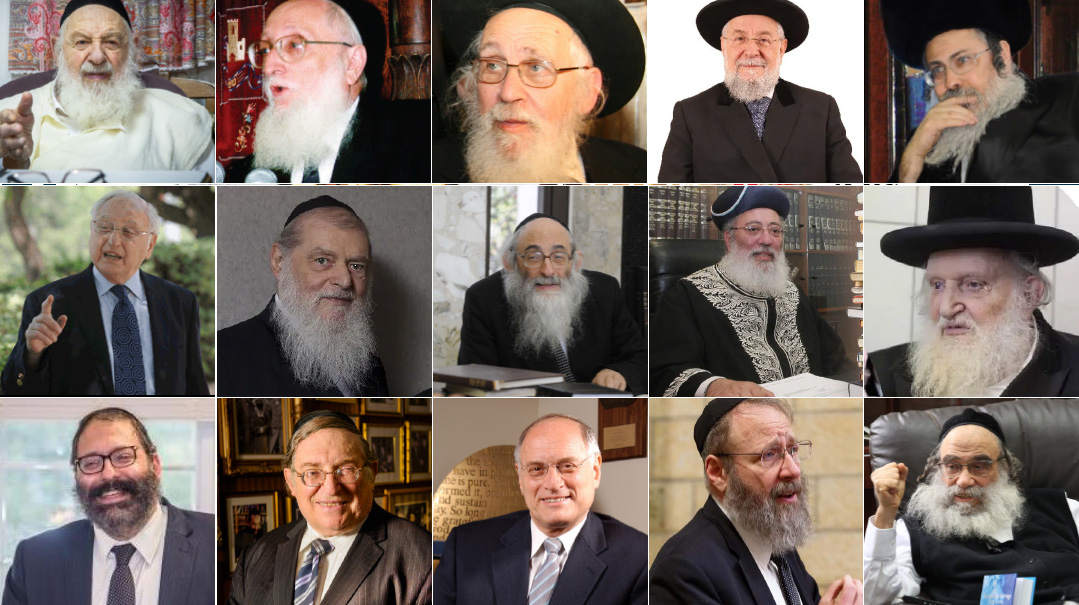A Mandate and a Mission

We carry a mandate to serve as the Shevet Levi of the Jewish nation

By Eli Paley, Publisher, Mishpacha Media Group
When we launched Mishpacha’s Hebrew edition over 35 years ago, it set a new standard for the chareidi world. The quality of the writing, the design, and the journalistic tone were all novel and trendsetting. But the biggest novelty was that here was a product that could find a warm welcome along the spectrum of frum society. Before Mishpacha, virtually every frum publication in Israel was sectarian, produced by and for a specific stratum of the community. A magazine that embraced and included all frum Jews was a new animal.
I realized, back then, that we would need a very special sort of editor in chief to actualize this vision. In Rabbi Moshe Grylak, we found the perfect architect. He had been appointed by Rav Shach ztz”l as the founding editor of Yated Ne’eman and had extensive life experience serving talmidei chachamim, public service, kiruv and chinuch — the sort of person who could relay Torah concepts in current terms without diluting their essence. He was also a creative visionary who dreamed big — constantly innovating new ideas, new formats, new frontiers — and a master pedagogue who gave our writers practical tools to improve their skills. Most of all, he was a person saturated in yiras Shamayim and the desire to engender greater love of Hashem among all Jews. He was the perfect “father” to our growing mishpachah.
It took some time, but soon enough, Mishpacha became a household name across a broad swath of society, a shared “home” for all our readers. As yirei Shamayim and shomrei Torah, more unites than divides us, so why not enjoy a shared publication?
The magazine quickly grew to include a weekly news package, a separate women’s magazine, and a weekly haven for children — today the standard package for many chareidi publications, but back then a groundbreaking format.
Our team built connections with rabbanim, askanim, and newsmakers. We updated our editorial and production standards. But the key to our success didn’t change. It has always been to drill down to that which unites us — our shared values, shared accomplishments, shared challenges and goals — and reflect them in print.
Mishpacha built a shared “table” that hosted a weekly gathering of various chareidi sectors, introducing them to gedolim from communities that until then had felt distant: the Satmar Rebbe could be featured one week, Rav Ovadia Yosef the following one. A close talmid of Rav Elyashiv shared his insights one month, the rosh yeshivah of Sanz reminisced about the Shefa Chaim the following one.
As the years went on, I started hearing voices from the English-speaking population — especially from youngsters who had spent some time in Eretz Yisrael and gotten to know and value Mishpacha. “Why are you limiting this publication to Hebrew speakers?” they asked. “Why not create an English-language edition and bring that special Mishpacha model to Jews across the globe?”
Then, at the onset of 2004, I joined a Vaad L’Hatzalas Nidchei Yisrael mission to Russia, during which I met noted rav and posek Rav Feivel Cohen ztz”l. When I introduced myself, he told me that he’d actually visited the Mishpacha offices a year earlier and asked to meet the publisher; he had hoped to persuade me of the need to publish the magazine in English as well. I hadn’t been at the office that day, but now he had another chance to impress upon me the need for an English-language edition.
It seemed like an impossible dare. I barely knew English and I was not very familiar with America’s frum population (both of those facts have changed over the years) but I realized I had a mission to fulfill.
I began doing my “homework,” studying the market and seeking out a kernel of staff members who could produce an English-language version of Mishpacha.
Mrs. Faigel Safran, our pioneering editor, took on the challenge of creating this new brew: utilizing some material from the Hebrew magazine, while bringing on new contributors to develop American-flavored content. Binyamin Rose and Yonoson Rosenblum were early, faithful contributors who brought deep knowledge and insight to the current affairs and opinion pages.
Tzirel Strassman was charged with publishing a weekly, standalone magazine for children — likely the first ever to appear for the frum public. Nomee Shaingarten was present from that very first issue, commanding and arranging all the logistics. Tuvia Heller, our first art director, developed the earliest templates of Mishpacha in English and created the workflow system that is the kernel of today’s operations. Shoshana Friedman, currently the managing editor, worked as a translator and editor.
Yisroel Besser joined during the early years, bringing his warmth, reverence for gedolim, and keen eye for communal trends. And right from the start, we included rabbinic advisors as a steady part of the weekly production process, to review all material and advertisements, and if necessary, to consult with gedolim when faced with bigger dilemmas.
Our first edition was published in time for Pesach of 2004. We sent it to print, arranged for distribution, and held out breath. Would this new public embrace our fledgling publication?
Soon enough, we discovered that we had tapped that shared language of believing Jews, and that Mishpacha’s English edition succeeded in widening the circle.
Since then our team has changed and grown. We have benefitted from the talent, insight, and savvy of so many editors, writers, and contributors. Rechy Frankfurter (currently of Ami), Bassi Gruen (former editor of Family First), and Libby Tescher (former editor of Mishpacha Jr.) left an invaluable mark over their years of devoted work. Today, our team is led by CEO Yehuda Nachshoni, who blends a deep understanding of media with an intuitive feel for human resources.
Under the direction of Shoshana Friedman, the editorial staff — Gedalia Guttentag, Faigy Hutner, Rachel Bachrach, Rachel Ginsberg, Shmuel Botnick, Nomee Shaingarten, Miriam Milstein, Sara Bonchek, Ricky Boles, Adina Lover, Rachael Lavon, and Chanie Nayman — continues to grow every year, laboring across continents and time zones, building a weekly product that celebrates Torah and mitzvos and the lives of Jews who live according to their dictates.
A burgeoning publication such as this one needs a strong foundation, and we’re fortunate to have Avi Lazar, CEO of our North American operation, and Hila Aftergut COO, aided by office manager Michal Frischman and sales manager Nina Feiner, running the business with attention to every detail and a shared passion for the product.
On the logistics and production end, a team of production managers, print liaisons, and distribution coordinators bring all that content to concrete reality, coordinating print schedules, trucking times, and delivery routes. This team has encountered increased challenges and complexity over the years, but week after week, they shepherd the magazine from pixels on a screen to a product you can touch and savor.
Producing a weekly magazine (which actually includes three weekly magazines!) is a complex team effort. We are fortunate to have been blessed with so many talented staff members — writers, proofreaders, advertising coordinators, bookkeepers, graphic designers, distributors — whose devotion to the product extends way beyond the particulars of their job description. The magazine is a testament to their gifts, and their devotion in never settling for second best.
Mishpacha today brims with energy and purpose. It aims to provide “something for everyone” — there’s hashkafic insight, sophisticated news analysis, thought-provoking opinion pieces, long-form journalism, travelogues, mental health tips, inspiring fiction, eye-catching recipes, comics for kids, and humor for adults.
Our editors constantly recalibrate and refresh the material, aiming to produce a package that is colorful yet classy, compelling but never sensationalist. Askanim know that it’s a platform with integrity, and prominent politicians see it as their entrée to an important demographic. Beyond that, the magazine has also succeeded in fostering a communal conversation about internal challenges in a forum that can grow passionate but always remains respectful. That, too, is a new standard.
Mishpacha has been a trendsetter in many ways. Perhaps most importantly, it has opened the door to a new generation of publications geared to the frum family. Visit any kosher supermarket in a frum concentration on a Thursday morning, and you will find shelves stacked with a huge variety of publications. Watch the checkout counters, and you can’t help but conclude that this thriving new industry has become an integral part of the Jewish nation’s oneg Shabbos experience.
In addition to its role as a pioneer, Mishpacha is also a publication with an impressive global reach. We print the magazine in five different printing houses every week, and it’s distributed on five continents. Its content is mentioned by rabbanim during shiurim, handed out to young mothers, spread on digital media, discussed on park benches and Shabbos tables, and is clipped and saved in homes across the globe.
About five years ago, during a meeting in Beit Hanassi (the Israeli president’s residence), I met two women. When they learned that I’m the publisher of Mishpacha, they began to tell me about the role it had played in their personal journeys. Neither had been Torah-observant. Some frum families began to invite them for Shabbos meals in Manhattan. Those homes were their exposure to Mishpacha Magazine.
“We got addicted!” they told me. “The magazine accompanied us along our process of teshuvah. In our shiurim and classes, we learned about Torah and mitzvos. In the magazine, we saw Yiddishkeit played out in full color. Mishpacha brought the frum lifestyle to life — it showed us how Yiddishkeit looks on a day-to-day basis.”
On a trip to Cape Town, South Africa, I met an elderly Jew who had recently become Torah-observant. “You should know,” he told me, “that Mishpacha is the link connecting me from distant Cape Town to the greater Jewish world.”
On a trip to England, I met a psychologist who told me, “You don’t know how many clients come to my office as a result of topics you discuss in the magazine. Not only do you give them information, you legitimize seeking help. You do it subtly, in a nuanced way — but you have caused real change.”
We constantly hear from readers who found new resources, support, or ideas to help them overcome personal challenges. From readers who were educated or inspired by what they read in our pages. From readers who were able to purge their homes of less-than-kosher reading material once they found a magazine that is true to their spiritual standards while not skimping on professional quality. From readers who look forward to a publication that connects them every week to Jews across the globe, celebrating and discussing their shares values, concerns, and heroes.
While the magazine speaks the lexicon and reflects the trends of English-speaking frum Jews, it still retains a certain quality thanks to its roots. The entire Jewish world sees Eretz Yisrael as its heart — its source of lifeblood — and even though much of our staff and content is deeply rooted in Diaspora communities, there’s an underlying sense that Mishpacha is an offering that holds a whiff of Eretz Yisrael.
We are currently experiencing times of tremendous challenge — for all Jews, and particularly those of Eretz Yisrael. This Yom Kippur saw perhaps the most painful and terrible explosion of conflict and hatred between sectors, with anti-religious sentiment coming to an ugly head. It seemed things could not get worse.
But on Simchas Torah, we experienced a day of barbaric horror, loss, and tragedy, and were plunged into a war that continues to affect us all. It is a time of grief and tension and great danger. But as our nation mourned, the terrible antagonism that had ripped through our society just days earlier began to dissipate. It became clear that even among Israel’s general public, there is a great thirst to know, to understand, to learn about our shared Jewish identity. As the conflicts faded and there emerged a genuine desire among various demographics to know more about their birthright, suddenly the story of our Jewish identity has become primary.
I hope and dream that the global frum community will take the opportunity to sound their voice in this emerging story, to help shape the new face of the Jewish nation — because our brothers are so hungry for what we can offer. We carry a mandate to serve as the Shevet Levi of the Jewish nation, to acquaint them with the shem Shamayim and to make it more beloved.
The mandate is not a new one, but the need is greater than ever. Now is the time. The world needs our voice.
(Originally featured in Mishpacha, Issue 1008)
Oops! We could not locate your form.







